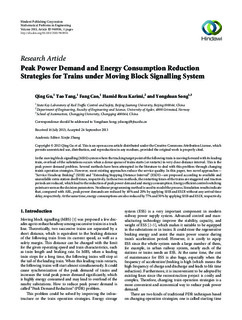| dc.contributor.author | Gu, Qing | |
| dc.contributor.author | Tang, Tao | |
| dc.contributor.author | Cao, Fang | |
| dc.contributor.author | Karimi, Hamid Reza | |
| dc.contributor.author | Song, Yongduan | |
| dc.date.accessioned | 2014-02-06T12:56:07Z | |
| dc.date.available | 2014-02-06T12:56:07Z | |
| dc.date.issued | 2013 | |
| dc.identifier.citation | Gu, Q., Tang, T., Cao, F., Karimi, H. R., & Song, Y. (2013). Peak power demand and energy consumption reduction strategies for trains under moving block signalling system. Mathematical Problems in Engineering. doi: 10.1155/2013/940936 | no_NO |
| dc.identifier.issn | 1024-123X | |
| dc.identifier.uri | http://hdl.handle.net/11250/137011 | |
| dc.description | Published version of an article in the journal: Mathematical Problems in Engineering. Also available from the publisher at: http://dx.doi.org/10.1155/2013/940936 Open Access | no_NO |
| dc.description.abstract | In the moving block signalling (MBS) system where the tracking target point of the following train is moving forward with its leading train, overload of the substations occurs when a dense queue of trains starts (or restarts) in very close distance interval. This is the peak power demand problem. Several methods have been attempted in the literature to deal with this problem through changing train's operation strategies. However, most existing approaches reduce the service quality. In this paper, two novel approaches - "Service Headway Braking" (SHB) and "Extending Stopping Distance Interval" (ESDI) - are proposed according to available and unavailable extra station dwell times, respectively. In these two methods, the restarting times of the trains are staggered and traction periods are reduced, which lead to the reduction of peak power demand and energy consumption. Energy efficient control switching points are seen as the decision parameters. Nonlinear programming method is used to model the process. Simulation results indicate that, compared with ARL, peak power demands are reduced by 40% and 20% by applying SHB and ESDI without any arrival time delay, respectively. At the same time, energy consumptions are also reduced by 77% and 50% by applying SHB and ESDI, respectively. | no_NO |
| dc.language.iso | eng | no_NO |
| dc.publisher | Hindawi Publishing Corporation | no_NO |
| dc.subject | consumption reductions | no_NO |
| dc.subject | decision parameters | no_NO |
| dc.subject | distance intervals | no_NO |
| dc.subject | energy efficient | no_NO |
| dc.subject | nonlinear programming methods | no_NO |
| dc.subject | operation strategy | no_NO |
| dc.subject | signalling systems | no_NO |
| dc.subject | stopping distance | no_NO |
| dc.subject | automatic train control | no_NO |
| dc.subject | energy efficiency | no_NO |
| dc.subject | target tracking | no_NO |
| dc.subject | energy utilization | no_NO |
| dc.title | Peak power demand and energy consumption reduction strategies for trains under moving block signalling system | no_NO |
| dc.type | Journal article | no_NO |
| dc.type | Peer reviewed | no_NO |
| dc.subject.nsi | VDP::Mathematics and natural science: 400::Mathematics: 410 | no_NO |
| dc.source.pagenumber | 1-11 | no_NO |
| dc.source.volume | 2013 | no_NO |
| dc.source.journal | Mathematical Problems in Engineering | no_NO |
| dc.identifier.doi | 10.1155/2013/940936 | |
